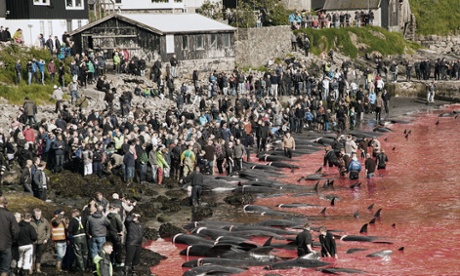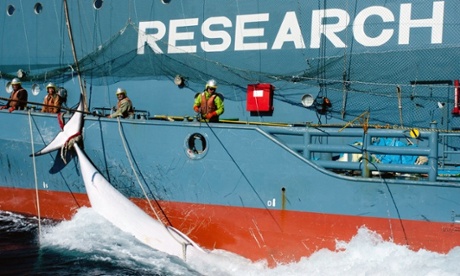If outsiders are dimly aware of an archipelago of 18 islands in the North Atlantic they probably picture the Faroes’ spectacular peaks or horrifying blood-red bays. The islanders’ annual slaughter of pilot whales, driven by flotillas of small boats on to the beach, is virtually the only occasion when the lives of 50,000 Faroese impinge upon the consciousness of the wider world.
Mike Day’s debut film, The Islands and the Whales, begins with a familiar juxtaposition of these images but soon veers into unexpected territory. Rather than a polemic against the cruelty of whale hunting, this deeply immersive documentary tells of a disappearing way of life, a weather-beaten people who are now buffeted by globalisation – and pollution. Whale meat is laced with mercury and other toxins, and an epic study by a Faroese doctor has revealed how eating it has impaired islanders’ cognitive function, reduced IQs and increased their risk of Parkinson’s disease. This is the big message for Day. “Our way of life is really ending theirs,” he says.
The film was a five-year slog for Day, a Scot who quit his job as a lawyer, bought a camera with his savings and sailed to the Outer Hebrides to capture Scotland’s last guga hunt. Guga are juvenile gannets that, for centuries, have been seized from their nests by cliff-climbing Hebrideans. After Day went out with the guga hunters, storms forced them to be rescued by helicopter – helping Day obtain a free aerial shot. While the film-maker repaired his boat in Stornoway harbour, some Faroese sailors pulled alongside. “They had this big, black block that they were carving off, and we said, ‘What’s that?’ They said, ‘pilot whale’. They salt-and-wind-dry the meat, and it’s like jerky I guess.” The Faroese invited Day to film their own traditional seabird hunt.
Day’s first visit to the Faroes, in 2011, coincided with the annual meeting of its whale hunting association. He arranged to show five minutes of his guga-hunting film in the hope of persuading islanders to let him document their globally condemned whale hunt. “The collection of government officials, police, hunting sheriffs [hunt regulators] and hunters were obviously very sceptical,” he says.
Outsiders’ cameras tend to get smashed at the whale hunts; suspicious locals have been duped by visitors, like Day, claiming to be filming neutral social anthropology. “There wasn’t much way of cutting through that scepticism, other than that the five minutes of film turned into the full hour.” Afterwards, Day was interrogated – mostly about what the hell he was doing in that Hebridean storm.
Thus began four years of filming on the Faroes. Day would drive 1,200 miles from his home in Scotland, across to Calais and up to northern Denmark to catch a ferry. He spent two three-month stints on the islands, taking a big sack of rice and living “hand-to-mouth” off local fish. While he eventually attracted funders from the Wellcome Trust to Kickstarter – the final budget was £500,000 – he was not confident he could make a whale film. “It’s a sanity-testing endeavour, that’s for sure,” he says. “I don’t know another artistic project where you’d have such a large budget with such uncertainty for such a length of time.”
Day devoted 53 weeks to filming, and the result is a beautifully shot, naturalistic and deeply intimate look at Faroese society. Day and his cameras almost seem to disappear; there’s no narration, no off-camera questions and no self-consciousness from the taciturn islanders; instead, the Faroese discuss over dinner how they are conflicted about the whale hunt. Their journey from a community without electricity and roads to a society with one of the world’s highest proportions of Facebook users is not without self-doubt.
“Time is our greatest capital,” says Day of his laborious method. “To be able to film the hunt probably took six months to a year, but to sit down at someone’s family dinner table was another matter. It takes a long time to get that level of intimacy we need to tell the story in that way.”
A doctor, Pál Weihe, emerges as one of the quiet heroes in a collection of stoical islanders. Day follows locals as they are tested by Weihe for heavy metals in their bodies as part of his epic 30-year longitudinal study which has helped expose the dangers of the concentration of pollutants up the oceanic food-chain. Day reveals the moving dilemma of Bárður Isaksen, a traditional hunter, and his wife, a nurse, who worries about the impact of pollution on their children.
For months, Day was unsure if he could document the notoriously unpredictable whale hunt. It only occurs if islanders chance upon a pod of pilot whales when they are hunting seabirds (a bizarre practice whereby fishermen scoop up fulmars floating on the water with what resembles an enormous lacrosse stick). Historically, whale meat was so important on these barren islands that it was a crime not to report a pod.
Roused into small boats, islanders herd the 20ft mammals into one of 17 designated hunting bays. Other islanders race on to the beach, brandishing a sinister-looking implement to sever the thrashing whales’ spinal cords before slitting them underneath so they bleed out. The meat is then meticulously divided into portions and wheelbarrowed away by each islander.
Day got wind of a whale hunt shortly after he and his sound recordist were rappelled 100ft down a cliff to a slippery ledge for a night to film the Faroese guga hunt. The sound man caught a chill. “We had to cover him with still-warm bird carcasses to keep him warm,” says Day. “Then the camera broke because there was so much fog and sea-spray.” On his way up, he span round on an uncoiling rope with the camera on his back: “There’s GoPro footage of that which still makes me ill.” Day had just enough time to recharge his camera batteries before the whale hunt began. When he arrived, “there were some people on the beach who were upset we were there with the camera but they found out we were the guys who had gone off the cliff,” he says. He was accepted. “We’d earned our stripes.”
In one shot, these big, sentient mammals convulsing on the beach make a noise that sounds like screaming. Was it hard to film? “It’s a difficult scene on many levels. First of all we’re trying not to get hit by a tail and killed. We’re trying not to sanitise the scene and at the same time we’re trying to recalibrate the audience to see it as it was to be there, which isn’t to come at it with our prejudices,” says Day.
“Of course it’s horrific, it’s horrible to see animals being slaughtered but if you eat meat it comes from that. The atmosphere at the hunt isn’t what you’d presume. It’s a harvest for them, free food, and it’s expensive to live there. At the beginning, when they’re standing on the beach there’s a real tension because everybody wants it to go well, and it’s not an easy task. The frenzy of the slaughter is framed by relief at the end when it goes well.”
Some way into the film, outsiders appear. Activists from Sea Shepherd, the anti-whaling charity, arrive in a plush campervan, with expensive boats and a piratical logo, intent on direct action to stop the slaughter. The islanders revolt, quietly, against the likes of Pamela Anderson. “Whether or not it’s intended, it’s perceived as gunboat diplomacy when you cruise into a place with multi-million pound vessels and skulls and crossbones,” says Day. “If an Iranian ship came up the Thames and said, ‘You can’t eat pork because to us it’s sinful and it’s an intelligent animal, so we’re going to picket your farms,’ people would be out on the riverbank with bacon rolls protesting. And of course that’s the reaction up there.”
According to Day, locals “who hadn’t eaten whale since they were kids suddenly became very defensive of their right to do it. It’s definitely perceived as cultural imperialism. The nations that have polluted the seas have turned up to tell them that eating whale is wrong. To me that embodied so much of our own lack of awareness.”
The anti-whaling activism had another consequence too: islanders became suspicious that the urgings of Weihe, the Faroese doctor, not to eat whale meat was part of a conspiracy to stop the hunt, undermining his public health message. Ultimately, says Day, “we’re not arguing for or against the whaling. People have their own minds made up about that issue. We’re saying if the pollution is so bad in the sea that the animals are that toxic, then all of these groups should be uniting over this bigger threat.”
- The Islands and the Whales is released on 29 March











